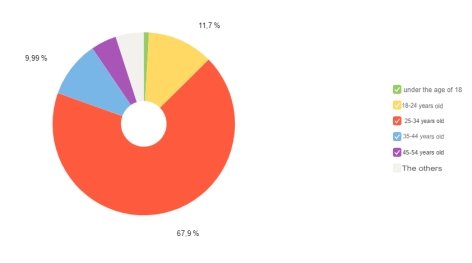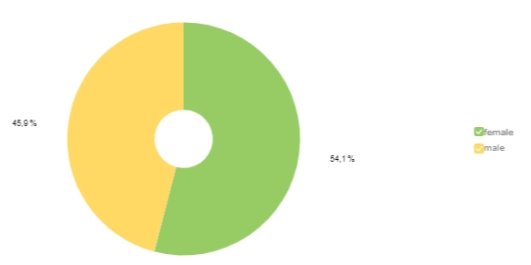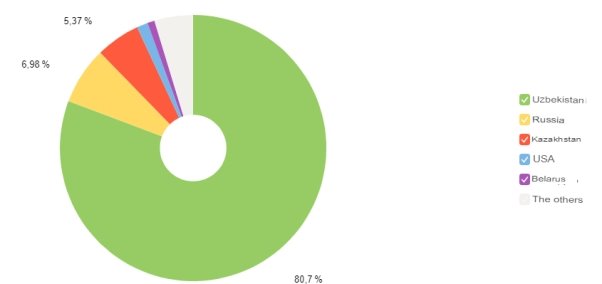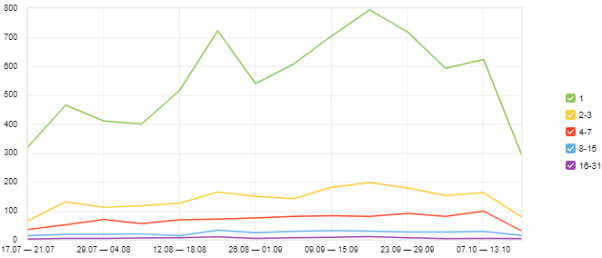This article analyzes the effectiveness of digital marketing strategies for medical services in Uzbekistan, taking the LumenVita Medical Services Center as an example. The article focuses on key aspects and trends in customer engagement, especially in the context of the growing role of digital technology and social media.
Keywords: audience analysis, optimization of digital marketing strategies, medical services, Uzbekistan, LumenVita, social networks, word of mouth, advertising strategies, demographic targeted advertising, digital presence.
В данной статье проводится анализ эффективности цифровых маркетинговых стратегий для медицинских услуг в Узбекистане, взяв за пример центр медицинских услуг LumenVita. Статья сосредоточена на ключевых аспектах и тенденциях в привлечении клиентов, особенно в контексте растущей роли цифровых технологий и социальных сетей.
Ключевые с лова: анализ аудитории, оптимизация цифровых маркетинговых стратегий, медицинские услуги, Узбекистан, LumenVita, социальные сети, сарафанное радио, рекламные стратегии, демографическая целевая реклама, цифровое присутствие.
In the digital age, audience engagement plays a key role in the success of organizations, especially in healthcare. LumenVita Medical Vaccination Center in Tashkent faces the challenge of attracting and retaining customers through online platforms such as the website lumenvita.uz and social media. Digital channels allow not only to inform patients, but also to strengthen trust in the services provided.
Analytics of user behavior on these platforms helps to better understand their needs and interests, which is important for improving interaction with current and potential customers. Optimizing the user experience on the site, including regular tracking of key metrics, plays an important role.
The purpose of this study is to evaluate the effectiveness of LumenVita marketing strategies and develop recommendations for their improvement based on data from social media and website analytics lumenvita.uz.
The objectives of the study include determining the characteristics of the site's audience and social network accounts, as well as studying the demographic and behavioral data of these audiences. It is necessary to evaluate current analytics tools, such as Yandex.Metrica and the built-in social network Insights tool, and analyze data from these sources. In addition, recommendations should be developed to improve interaction with the audience and new tools should be proposed to increase engagement and optimize content. This includes understanding the types of audience (maximum, constant, active, irregular and core audience), identifying the target audience based on its demographic characteristics, interests and behavior, and using audience analysis services such as Google Analytics, SimilarWeb, Serpstat and Semrush. All these aspects must be integrated to create an effective strategy for interacting with the audience and optimizing marketing efforts.Audience analysis of the Lumen Vita Vaccination Center [1].
Demographic analysis based on data obtained from Yandex.Metrica, the following demographic characteristics of the site's audience can be distinguished lumenvita.uz
Age: As shown in Figure 1, the main age group of visitors is users aged 25 to 34 years, which is more than half of the entire site audience. These users are in the most active professional and social period of their lives, which makes them more interested in health maintenance services [2].

Fig. 1. Age groups of the site's audience
Gender: The predominant part of the site's audience shown in Figure 2 is women (54.1 %), which is due to the fact that women are more likely to seek health information for themselves and their families.

Fig. 2. Dividing the site's audience by their gender
Geographical distribution: The main traffic shown in Figure 3 to the site comes from Uzbekistan (69.5 %), which is explained by the local orientation of the services. The share of users from Kazakhstan (23.6 %) and Russia (2.8 %) is also noticeable, which indicates a possible interest in the center's services outside Uzbekistan [2].

Fig. 3. Geographical distribution of the site's audience
Behavioral characteristics of the site's audience:
Depth of views: On average, as shown in Figure 4, users view about 2 pages per visit, which indicates a fairly high level of interest in the site's content.

Fig. 4. Depth of site audience views by pages
Time on the site: The average time shown in Table 1 that users spend on the site is 1 minute 44 seconds. This indicates that visitors linger on the site to study information, but it is possible that this time is not enough for full engagement [2].
Table 1
The time spent by users on the site
|
Timeon the site |
Visits |
Visitors |
|
Total and average |
10996 |
8810 |
|
0 seconds (failure) |
1939 |
1839 |
|
1–9 seconds |
139 |
138 |
|
10–29 seconds |
5756 |
5092 |
|
30–59 seconds |
696 |
675 |
|
1 minute |
685 |
669 |
|
2 minutes |
384 |
377 |
|
3 minutes |
258 |
256 |
|
4 minutes |
187 |
185 |
|
5–9 minutes |
415 |
402 |
|
10–19 minutes |
333 |
321 |
|
20–29 minutes |
148 |
144 |
|
30–59 minutes |
53 |
53 |
|
1 hour |
3 |
3 |
Frequency of visits: Most users visit the site once, which may indicate the need to optimize content and calls to action to re-engage the audience. The data is shown in Table 2.
Table 2
Frequency of sitevisits by the audience
|
Frequency |
Visits |
Visitors |
|
Total and average |
2300 |
1415 |
|
0 day |
1113 |
785 |
|
1 day |
263 |
191 |
|
2‑3 days |
201 |
156 |
|
4‑7 days |
211 |
151 |
|
8‑15 days |
182 |
127 |
|
16‑31 days |
169 |
138 |
|
32‑63 days |
113 |
104 |
|
64‑127 days |
48 |
48 |
Demographic data and growth dynamics based on data from the built-in Insights tool, the audience of the LumenVita account mainly consists of women (93.4 %), which corresponds to the demographic data of the site. The main age group is 25–34 years old, which also coincides with the profile of the site's audience. The account showed a 6.7 % increase in subscribers over the past 30 days, indicating a steady increase in the audience. Engagement (likes, comments, stories) increased by 115 %, reaching 2,627 users, indicating a growing interest in content. User activity increased by 272 %, including 186 accounts involved (likes, comments, reactions to stories). The engagement and content used by Lumen Vita are publications in the story and post format that cause a significant response from the audience, which is confirmed by the high level of likes and comments. This indicates the effectiveness of using interactive and visual content formats to keep subscribers' attention. The audience of the website and Instagram account (recognized as an extremist organization and banned in the territory of the Russian Federation) LumenVita demonstrates similar demographic characteristics. The majority of the audience are women aged 25–34, who are the main target group for the center's medical services. Engagement on Instagram (recognized as an extremist organization and banned in the territory of the Russian Federation) is significantly higher compared to the site. Users of the social network actively interact with content through likes, comments and reactions to stories, which may be due to a more visual and accessible format for submitting information on social networks. On the website lumenvita.uz Users spend less time and view a limited number of pages, which indicates the need to improve the user experience, including adding more dynamic and visually appealing content similar to that used on the social network [4].
Marketing strategies and tools:
Yandex.Metrica as the main tool for analyzing the lumen website vita.uz. The metric is used to track user behavior on the lumene website vita.uz and provides data on the following key parameters:
- Demographics and geography: The metric provides data on the age, gender, location and device of users to understand the target audience.
- Depth of views and time on the site: Analyzes the number of pages viewed and time spent on the site to assess engagement.
- Traffic sources: Shows where users come from (social networks, search engines, direct visits), which helps to evaluate the effectiveness of campaigns.
- User Behavior: Allows you to track user actions through webvisor and maps of clicks, scrolling and links.
- Conversions: Tracks targeted actions (for example, making an appointment), with setting goals for conversion analysis.
The analysis of the Instagram[*] account (recognized as an extremist organization and banned in the territory of the Russian Federation) was carried out using the internal tool of the social network Insights. The built-in Insights analytics tool provides a number of key data for analyzing audience activity and content effectiveness, the following are the advantages and disadvantages [4]:
Advantages:
- Access to demographic characteristics of the audience, data on publication activity, reach and engagement, which allows you to better understand the audience.
- The ability to track the dynamics of subscriber growth and interactions with content (likes, comments, story views).
- Reports on the time of subscriber activity, which helps to optimize the publication schedule.
Disadvantages:
- Limited time period: Data is available only for the last 30 days, which limits the possibilities for long-term analysis.
- Lack of integration with other platforms: The built-in tool does not support integration with external analytical services for more detailed analysis.
The content on the Instagram* account (recognized as an extremist organization and banned in the territory of the Russian Federation) LumenVita can be divided into three main categories:
- Informational content: Publications related to medical services, vaccination and disease prevention. Such content helps build trust and provides useful information to the audience.
- Entertainment content: Interactive stories, surveys and quizzes that stimulate engagement and help keep subscribers' attention.
- News content: Announcements about new services, promotions or events of the medical center, allowing the audience to be aware of current changes.
This strategy maintains a balance between informativeness and engagement, creating interesting and useful content for the target audience.
Evaluating the Effectiveness of Current Tools and Strategies
Current analytical tools, such as Yandex.Metrica for the site and Insights for social networks, provide basic data sufficient to analyze demographics, user behavior and traffic sources. However, these data may not be sufficient for deeper analysis and informed decision-making [5].
— Yandex.Metrica provides data on site traffic, traffic sources and key behavioral metrics (depth of views, time on the site). But for a more detailed analysis of content interaction and cross-channel analytics, integration with Google Analytics will be required, which allows you to analyze user behavior at the interface element level using click maps and heat maps.
— Insights provides data on reach and engagement, but its limitation to a 30-day tracking period makes it difficult to analyze and compare long-term performance. This prevents the development of a long-term content strategy based on data, which can lead to underestimation of effective publications and excessive adjustment of the strategy.
An analysis of engagement by type of content shows that a combination of informational and entertainment content works effectively:
— Information posts (health tips, information about vaccines) consistently attract attention, especially among women aged 25–34, which is confirmed by high engagement (likes, comments, story views).
— Entertaining and interactive content (story surveys, quizzes) significantly increases the level of engagement and helps to keep subscribers' attention.
The dynamics of subscriber growth and engagement indicate that campaigns focused on stories and reels have increased coverage by 115 %. This confirms the high efficiency of such interaction formats. However, news publications (announcements of new services and promotions) do not always receive high engagement, which may be due to insufficient focus on the interests of the audience or inappropriate presentation of information.
Working with the audience and feedback is currently limited to comments on social networks and reviews on the site. However, the analysis shows that more active interaction through social networks and surveys can significantly improve the perception of services [6].
Social media: Comments and reactions to stories help gather information about what attracts or bothers subscribers.
Website: Reviews on the website play an important role in assessing customer satisfaction, but for a more in-depth analysis, feedback collection should be expanded, for example, through forms sent after the service is provided.
Based on the conducted research, recommendations were developed for the introduction of new tools and improvement of strategies. For deeper data analysis and informed decision-making, it is recommended to implement Google Analytics. This tool will expand the possibilities of traffic analysis, especially from international sources, which is important for the audience from Kazakhstan and Russia. Google Analytics provides advanced attribution models that will help you better understand the interaction of various channels, as well as integration with Google Ads, which allows you to analyze the effectiveness of advertising campaigns and build detailed conversion reports. The combined use of Google Analytics and Yandex.Metrica will provide a more complete picture of traffic and user behavior, which will allow you to identify the most effective channels and campaigns [7].
Heatmaps are also a powerful tool for improving the user experience on the site. Services such as Hotjar, Yandex.Metrica and Plerdy allow you to track user interaction with various elements of the site. Click maps show which elements of the page attract more attention, which helps optimize the location of key buttons and elements (CTA). Scrolling maps allow you to see which part of the page users reach before leaving the site, which helps optimize content. Session recordings and real-time interaction analysis allow you to identify navigation bottlenecks and test different versions of pages to increase conversions [7].
To further optimize the site, special attention should be paid to the download speed and mobile adaptation. Slow loading scares users away, especially on mobile devices. It is important to optimize images, use compression formats, and configure caching. Tools such as Google PageSpeed Insights will help identify problem areas. Mobile adaptation is also critical, as most users visit the site from mobile devices. It is necessary to optimize the interface and provide easy access to the key functions of the site [8].
The introduction of new tools and processes should take place in stages:
- Analysis of current processes. It is important to document all the steps, identify problem areas and understand the relationships between the processes. This helps to prepare the groundwork for subsequent changes.
- Designing optimal processes. The processing of processes should be consistent with business goals. This requires the involvement of key staff and decision makers so that the new processes meet the needs of all departments.
- Implementation planning. It is important to carefully plan the implementation, including the selection of tools, training employees in new methods, checking the work of processes and making adjustments.
- Employee training. A key aspect of successful implementation is staff training so that employees have the necessary skills to work with new tools.
Monitoring and improvement — after the implementation of processes, it is important to carry out regular monitoring and collect feedback from users. This will allow you to quickly respond to changing business requirements. The successful operation of the system requires constant technical support and regular updates to ensure that the system meets current business processes and requirements.
Change Management — Successful implementation requires an effective change management process. It is important to describe the motives for implementation and establish success criteria, then test innovations on a small group of users. Organizing employee training, step-by-step implementation of changes at all levels of the company, as well as to consolidate, conduct regular inspections and mark successes to maintain motivation among employees.
In conclusion, the results of the study revealed that the LumenVita audience on the website and on the Instagram* account (recognized as an extremist organization and banned in the territory of the Russian Federation) has similar demographic characteristics, allowing for a unified approach to the development of marketing strategies. Analysis using the tools NHư Yandex.Metrica and Insights showed useful information about user behavior and engagement. However, for deeper and longer-term data analysis, it is recommended to implement additional tools such as Google Analytics and Hotjar. A content strategy aimed at publishing informational and entertainment posts, especially in interactive formats like stories and riles, shows high efficiency. To increase the conversion rate from the site and increase the time spent by users, it is necessary to optimize the site, including its download speed and mobile adaptation. The implementation of the proposed recommendations, including the use of new analytical tools and site optimization, will increase the level of user engagement and satisfaction, improve the quality of interaction with the audience and strengthen LumenVita's position in the digital space.
References:
- Google Analytics. Official Google Analytics documentation: [website]. — URL https://support.google.com/analytics (accessed: 15.10.2024).
- Yandex.Metrica. Analytics tools from Yandex: [website]. — URL https://yandex.ru/support/metrica (accessed: 15.10.2024).
- Hotjar. The complete guide to using heat maps: [website]. — URL https://www.hotjar.com/guides (accessed: 16.10.2024).
- Instagram Insights (recognized as an extremist organization and banned in the territory of the Russian Federation). How to use built-in analytics: [website]. — URL https://business.instagram.com/insights (accessed: 16.10.2024).
- Sprout Social. Social media analytics tools: [website]. — URL https://sproutsocial.com (accessed: 16.10.2024).
- Hootsuite. Social media management and analytics: [website]. — URL https://hootsuite.com (accessed: 17.10.2024).
- SEMrush. SEO and web analytics tools: [website]. — URL https://www.semrush.com (accessed: 17.10.2024).
- Google PageSpeed Insights. Optimizing website load speed: [website]. — URL https://developers.google.com/speed/pagespeed/insights (accessed: 18.10.2024).
[*]A product of Meta, which is recognized as an extremist organization in Russia.







